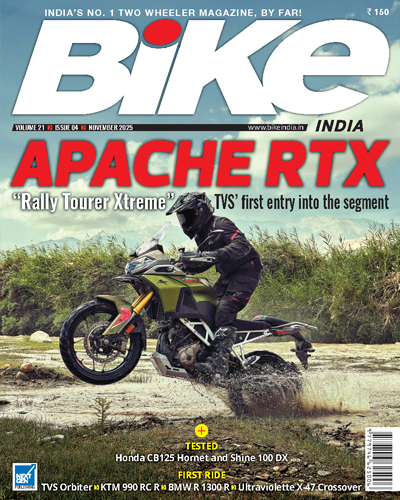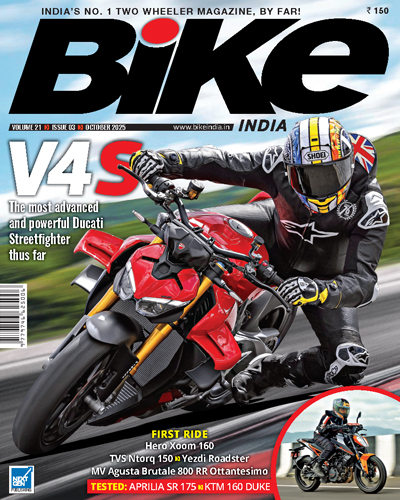
The CB125 Hornet is a compact Honda with big-bike looks and serious street presence
[Read more…] about Honda CB125 Hornet – The Little Hornet with a Lethal StingBest Bikes in India | No.1 Two Wheeler Magazine

The CB125 Hornet is a compact Honda with big-bike looks and serious street presence
[Read more…] about Honda CB125 Hornet – The Little Hornet with a Lethal Sting

Finally, we have an adventure sport bike from TVS Motor. It has been long overdue, as TVS has been racing motorcycles in motocross and rallying for more than 40 years. Having built off-road competition motorcycles for over three decades, the company should be best equipped to make an adventure sport bike with all its experience compared to other Indian manufacturers.
The TVS Apache RTX is big for a 310-cc motorcycle. It does not use the same engine as the RR310, and the RTR310 is derived from BMW. It is powered by an all-new engine designed and developed in-house by TVS that was unveiled at last year’s Moto Soul Festival in Goa. You will find the RTX first ride report in this very issue.
Dual-purpose motorcycles are most suitable for our country due to the poor quality of the road surface everywhere, and long-travel suspension gives some relief to the rider’s back. There is hardly a road in the country free from potholes or sharp joints between two concrete slabs. The manholes either tend to protrude by three to four inches or nestle in a hollow three to four inches below the road surface, giving the rider a severe jolt in the back. To top all these, the traffic policemen stand on the road to ask if one has re-registered the bike and paid the road tax (and the green tax for a bike that has completed 15 years), or if the bike is registered in another state. Ironically, the same policeman will not stop a family of three or four on a two-wheeler or some goons riding down the wrong way.
It is very funny. If you are talking on the mobile phone while driving a car, the police will fine you with alacrity, which is good, but a two-wheeler rider with his phone stuck between his shoulder and his ear and talking animatedly on the go invites neither a reprimand nor a punitive action.

This year, Bajaj Auto celebrates 25 years of the Pulsar brand and TVS Motor 20 years of the Apache brand.
In 2002, Bajaj launched the Kawasaki 175 Eliminator. The first ride was held at their Chakan test track. At the conclusion of that ride, we were given a short ride on the Pulsar 180, the motorcycle that was going to be launched later that year. The Pulsar brand entered the market with a 150-cc and a 180-cc bike. Now we have it starting with 125 cc and going all the way up to 400 cc.
Pulsar has become a household name not only in India but all over the world.
As for TVS, which is celebrating 20 years of its performance brand Apache, we had done a track test of all its 150-cc bikes at the MMRT racetrack in Chennai, and I vividly recall the Apache frightening the daylights out of me because the bike was all over the place due to its very short wheelbase. The Apache RTR160 that followed later was a brilliant bike. Now the Apache brand has grown to 310 cc and is well known across the globe.
The two slabs of the Goods and Services Tax (GST), 18 per cent and 40 per cent, are there to show the people that the authorities have helped the ordinary man by penalizing those who can afford to buy bikes over 350 cc. On the one hand, the government says that it wants the Indian manufacturers to compete in the global market, and, on the other, penalizes the manufacturers who make bikes over 350 cc to be able to compete with the best in the world. Revenue-wise, it will not make much difference to the exchequer because the number of bikes over 350 cc sold is minuscule compared to the smaller commuter motorcycles. In our opinion, the GST Council should reconsider the 40 per cent tax on bikes over 350 cc.

The government has decided to lower the Goods and Services Tax (GST) rate for motorcycles. Come 22 September 2025, there will be two rates: while motorcycles with a capacity of up to 350 cc will attract the lower rate of 18 per cent. Those above 350 cc will entail 40 per cent GST, as per the official notification from the GST Council as of now.
The idea of two slabs is not good for the two-wheeler industry. It will not encourage manufacturers to develop large-capacity motorcycles with a view to competing on the international level. As of today, only two Indian manufacturers make motorcycles with a capacity of over 400 cc: Classic Legends and Royal Enfield. Ideally, the GST for all motorcycles should be 10 per cent.
Furthermore, the cost of sub-125-cc bikes will not come down significantly on account of the imminent rule that will make the anti-lock braking system (ABS) mandatory for such motorcycles. Once the rule comes into force, it will increase the price of small bikes. In India, we have plenty of motorcycle-related norms compared to some of the other countries in the world. Instead of making things mandatory for bikes, the government would do well to concentrate on better roads and infrastructure for the people who pay one of the highest road taxes in the world.
The use of E20 fuel is going to wreak havoc, especially on old bikes that have carburettors. The corrosive nature of the alcohol-based fuel will disintegrate the rubber parts, such as rubber intake manifolds and float valves, and cause damage to the piston cylinder liner and the combustion chamber when the bike is not in regular use.
On another note, there should be a concise syllabus for schoolchildren, teaching them the dos and don’ts of traffic and instilling basic civic sense related to how to behave on a public road and obey the basic traffic rules.